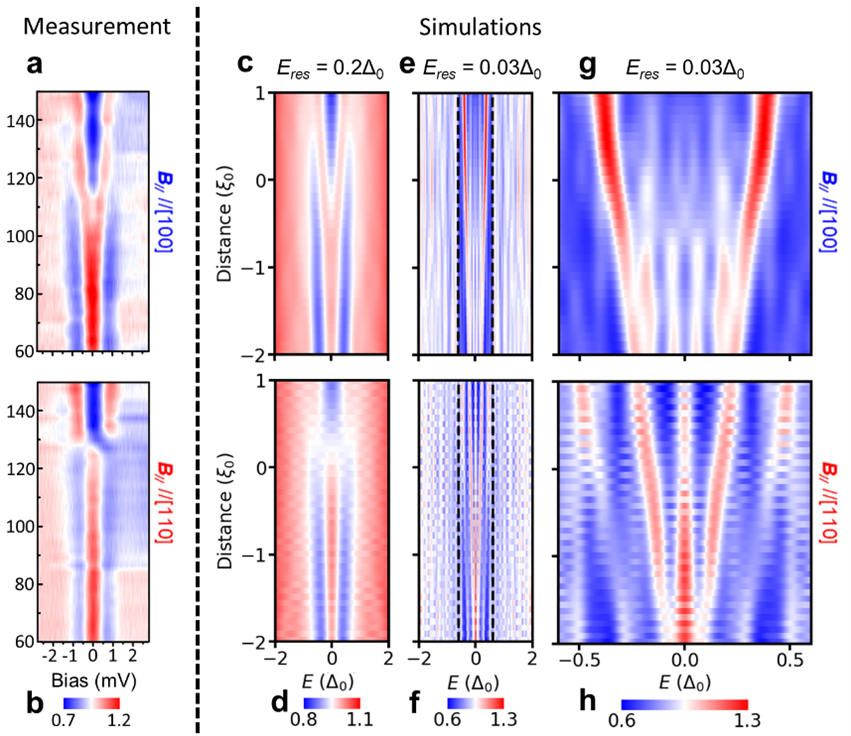A collaborative research team led by Prof. Junwei Liu, Associate Professor in the Department of Physics at the Hong Kong University of Science and Technology (HKUST), and Prof Jinfeng Jia and Prof Yaoyi Li from Shanghai Jiao Tong University (SJTU), has identified the world’s first multiple Majorana zero modes (MZMs) in a single vortex of the superconducting topological crystalline insulator SnTe and exploited crystal symmetry to control the coupling between the MZMs. This discovery, which is published in Nature, offers a new pathway to realizing fault-tolerant quantum computers.
A MZM is a zero-energy topologically nontrivial quasiparticle in a superconductor that obeys non-Abelian statistics, allowing for inequivalent braiding sequences, even though the total number of exchanges is the same (Fig. 1a). This contrasts with ordinary particles, such as electrons or photons, where different braiding always results in the same final state (Fig. 1b). This unique property protects MZMs from local perturbations, making them an ideal platform for robust fault-tolerant quantum computation. Although significant progress has been made in engineering artificial topological superconductors, the braiding and manipulation of MZMs remain extremely challenging due to their separation in real space, which complicates the necessary movements for hybridization.

Fig. 1 Non-Abelian and Abelian exchange statistics. (a) Non-Abelian exchange statistics of MZMs, the final state differs if the order of two pair-wise exchange operations is interchanged. (b) Abelian exchange statistics of ordinary particles such as electrons and photons, swapping the order of the exchange operations will not affect the final state.
This recently published work, reported jointly by the theoretical group at HKUST and the experimental group at SJTU, took a completely different approach to eliminate these bottlenecks by taking advantage of the unique feature of crystal-symmetry-protected MZMs. Leveraging their extensive experience in low-temperature scanning tunnelling microscopy, high-quality sample growth, and large-scale theoretical simulations, the collaborative team demonstrated for the first time the existence and hybridization of magnetic-mirror-symmetry-protected multiple MZMs in a single vortex of the superconducting topological crystalline insulator SnTe. Furthermore, the MZM hybridization could be manipulated using controlled methods that do not require real space movement or strong magnetic fields (Fig. 2).
The experimental group at SJTU observed significant changes in the zero-bias peak, a strong indicator of MZMs, in the SnTe/Pb heterostructure under tilted magnetic fields (Fig 2a-b). The HKUST theoretical team subsequently performed extensive numerical simulations that unambiguously demonstrated the anisotropic responses to tilted magnetic fields indeed originate from crystal-symmetry-protected MZMs. By utilizing the kernel polynomial method, they successfully simulated large vortex systems with hundreds of millions of orbitals, enabling further exploration of novel properties in vortex systems beyond just crystal-symmetry-protected MZMs. This joint research led by Profs. Liu, Jia, and Li opens a new frontier for detection and manipulation of crystal-symmetry-protected multiple MZMs. Their findings pave the way for the experimental demonstration of non-Abelian statistics, and the construction of new types of topological qubits and quantum gates based on crystal-symmetry-protected multiple MZMs.

Fig. 2 Signatures of crystal-symmetry-protected MZMs. (a, b) Spatially resolved tunnelling conductance spectra in tilted magnetic fields. (c-h) Simulated local density of states for vortex states in tilted magnetic fields.
This groundbreaking work was published in the article Nature 633, 71 (2024) titled “Signatures of hybridization of multiple Majorana zero modes in a vortex” with Prof. Junwei Liu (HKUST), Prof. Yaoyi Li (SJTU), and Prof. Jinfeng Jia (SJTU) as corresponding authors and Mr. Chun Yu Wan (HKUST), Dr. Tengteng Liu (SJTU), and Dr. Hao Yang (SJTU) as the co-first authors. The work was supported by the Ministry of Science and Technology of China, the National Natural Science Foundation of China, the Strategic Priority Research Program of Chinese Academy of Sciences, the Science and Technology Commission of Shanghai Municipality, the Innovation program for Quantum Science and Technology, the China National Postdoctoral Program for Innovative Talents, and the Hong Kong Research Grants Council.